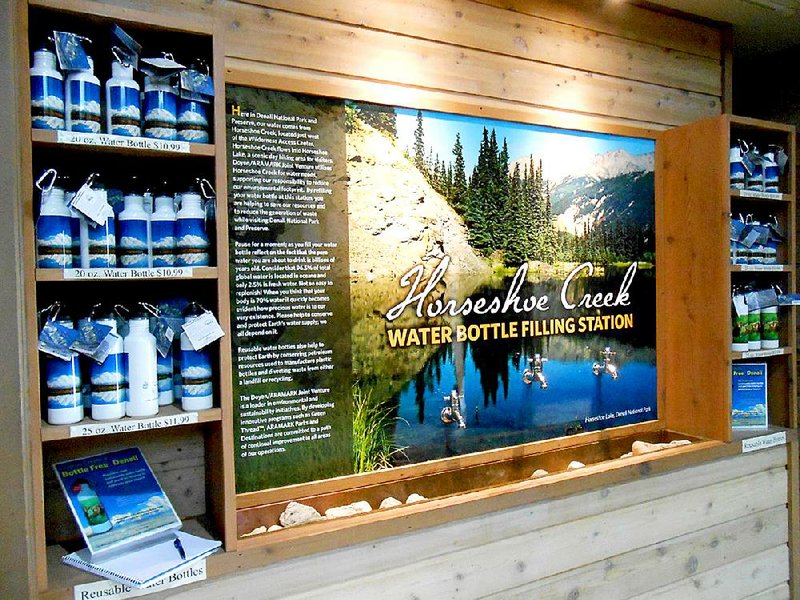WASHINGTON — First, the National Park Service said it would cut back on selling its visitors bottled water to reduce the litter left behind.
Now, Congress — under pressure from the bottled-water industry — is threatening to cut off the federal money the Park Service is using to replace the disposable plastic water bottles with refilling stations.
But the Park Service said it will keep encouraging parks to halt bottled-water sales, even with an edict from Congress. Park officials say they have such strong support for the bans that they would instead rely on help from friends and allies, the nonprofit groups that donate to park projects and the companies that have been selling the bottled water in the first place.
“We believe there are plenty of workarounds,” said Shawn Norton, the Park Service’s branch chief for sustainable operations and climate change. “We believe our friends groups and our concessionaires will step up if needed to fill this need.”
The cost of buying, installing and maintaining the refilling stations in about 20 parks would almost certainly come from the Park Service’s network of friends groups and concession companies that contract with the agency to sell food, drinks, gifts and supplies.
“I feel very confident that those dollars will start flowing,” Norton said.
The Park Service’s David vs. Goliath stand comes during a standoff between the agency and the $13 billion bottled-water industry over a policy Director Jonathan Jarvis enacted four years ago. Facing overflowing garbage cans and ever-growing recycling and landfill costs, he told the 408 parks, national monuments and historical sites across the country that they could eliminate sales of disposable plastic water bottles, as long as refilling stations and sales of reusable bottles replaced them.
About 20 parks have taken Jarvis up on the offer, including the Grand Canyon, Canyonlands, Arches, Zion and Bryce Canyon, with more in the pipeline, officials said. Refilling stations cost anywhere from $2,000 to $15,000, Norton said, depending on how much pipe must be laid to a water source, which often is a spring.
Things got ugly this spring, when the International Bottled Water Association, which represents about 200 companies, mounted a lobbying campaign to stop the Park Service’s latest effort at sustainability. The industry has found allies in House Republicans, particularly those with bottled-water plants in their districts and states.
The hard work may pay off: Rep. Keith Rothfus, R-Pa., whose state employs 6,800 people at bottled-water companies, in July tucked a last-minute amendment onto a government appropriations bill pending in the House. It prohibits the Park Service from spending taxpayer money to implement any ban on sales of bottled water.
Joe Doss, president and chief executive officer of the bottled-water association, said that even if the Park Service can legally use private money to pay for bottled-water alternatives, it should be careful about even thinking of subverting Congress.
“My thought would be, you certainly don’t want to be doing things that Congress has indicated they don’t want you doing,” Doss said. “It would seem prudent, if one were a Park Service official, to see that if there’s a clear sense of Congress, you’d have to take that into consideration and you don’t do what goes against that.”
Contrary to what environmentalists might think, the bottled-water industry is “a very small industry made up of very small, family-run second- and third-generation businesses,” Doss said. (It also includes companies with names like Deer Park and Evian, which are parts of multinational corporations.)
The bottled water association has spent about $510,000 to lobby members of Congress since 2011, records show, this year making the national parks one of its top lobbying targets.
Some of the Park Service’s biggest concessionaires seem to have their own sustainability agendas. At Xanterra Parks & Resorts Inc., based in Greenwood Village, Colo., just south of Denver, vice president of sustainability director Catherine Greener called for some perspective.
“When guests started to come to these iconic places, there was no such thing as water in a PET bottle,” she said, referring to polyethylene terephthalate, a packaging plastic that can be recycled to reduce waste going into landfills.
Greener said Xanterra has taken a financial hit in parks that no longer sell bottled water, but the company also works with the Park Service to install refilling stations as part of its contract.
“Like the paper versus plastic bag controversy, we want to minimize our carbon footprint,” she said. “Should the rider pass [Congress], we would work very closely with the Park Service to make sure we have the most sustainable option possible.”
Aramark, another concession company, installed refilling stations on its own at the six parks where it operates, including Denali, Yosemite, Glacier Bay and Olympic, spokesman David Freireich said. “We are moving away from plastic bottled water and introducing alternatives, such as resealable aluminum bottles; cans and cartons; and water fountains, water walls and filling stations.”
“As always, we’ll work with the NPS and our partners to develop a plan for installation of future refill stations,” if the measure in Congress moves forward, he said.
Acadia National Park in Maine hasn’t stopped selling bottled water. “But if the Park Service came to us and said, ‘This is one of our top priorities,’ we would do it,” said Stephanie Clement, conservation director for Friends of Acadia, a nonprofit group that raises money for park projects.
Clement has her own ideas about the will of Congress. “They’re responsible for funding and taking care of the parks,” she said. “I wouldn’t want to let them off the hook on this.”
One place where the industry probably doesn’t have to worry about losses to its bottom line is Big Bend National Park in west Texas, a weather-beaten desert.
“We don’t have much of a water supply,” said Arlene Griffis, membership coordinator for Friends of Big Bend National Park. “If we had refilling stations, we would probably run out of water pretty fast. The park depends heavily on bottled water.”
